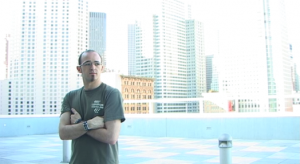 “Don’t Listen Alone” has its genesis in 2007 when Jono suggested I follow the “four large gents” around behind-the-scenes at that year’s LugRadio Live event. The plan was to record what the weekend is like for the presenters. I was pleased but a little taken-aback to be asked to do this. If it’s not apparent enough already, I’d never attempted a project like this before, though I’d been involved in the AV crew at LugRadio Live since 2006. I’d never made a documentary, never tried to tell a story through video. Mostly I’d videoed talks at conferences, which is a lot easier: The content is someone else’s responsibility, you just have the technical task of capturing it on camera.
“Don’t Listen Alone” has its genesis in 2007 when Jono suggested I follow the “four large gents” around behind-the-scenes at that year’s LugRadio Live event. The plan was to record what the weekend is like for the presenters. I was pleased but a little taken-aback to be asked to do this. If it’s not apparent enough already, I’d never attempted a project like this before, though I’d been involved in the AV crew at LugRadio Live since 2006. I’d never made a documentary, never tried to tell a story through video. Mostly I’d videoed talks at conferences, which is a lot easier: The content is someone else’s responsibility, you just have the technical task of capturing it on camera.
There wasn’t really enough useful footage from LugRadio Live 2007 to tell a story worthy of release, so what was shot that weekend ended up in the trailer for LugRadio Live 2008 USA. The gents asked me to fly out to LugRadio Live 2008 USA with them and, again, video the trip for posterity. Oh, and to run the crew for the weekend too! Travelling to the US to host an event was such a big thing for the “four idiots from Wolverhampton” that they wanted there to be a lasting record, a behind-the-scenes video of the trip. The interviews I conducted with the presenters during the trip reflects the focus on the US event. When they cancelled the show not long after we returned to the UK, however, the project morphed into the story of the end of LugRadio .
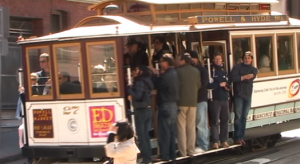 I flew out to San Francisco with the gents and spent the long weekend videoing them around the city and preparing for the event. On the day we had allocated to get over the jet-lag we went to Alcatraz, the infamous prison island. Whilst there I shot some stills, ostensibly for a future redesign of the LugRadio website. That project was shelved when the gents cancelled the show, but some of the photos can be seen in this documentary for the first time. I also spent about half an hour interviewing each of them about the trip and about LugRadio in general, each in a different location around the LugRadio Live venue.
I flew out to San Francisco with the gents and spent the long weekend videoing them around the city and preparing for the event. On the day we had allocated to get over the jet-lag we went to Alcatraz, the infamous prison island. Whilst there I shot some stills, ostensibly for a future redesign of the LugRadio website. That project was shelved when the gents cancelled the show, but some of the photos can be seen in this documentary for the first time. I also spent about half an hour interviewing each of them about the trip and about LugRadio in general, each in a different location around the LugRadio Live venue.
Aq was the first interview recorded, conducted while the event was still being set up, hence the background noise. Jono was interviewed on the balcony outside LRL USA 2008. He wanted to avoid the sun ahead of meeting his future in-laws, so we kept in the shade near the building. This meant that the fabulous San Francisco skyline was over-exposed though! My favourite image from the US trip is Chris standing in the basement. It just looks so grimy! I chose the location as he had spent half a day down there waiting for deliveries to arrive. Adam was interviewed in Union Square on the Monday after the event, before they left for the airport. I was staying in San Francisco for a few more days, and the establishing shots of life around the city were taken then.
Within a month or so of us returning from the US, before I had the chance to do anything with the video footage, the gents announced they were cancelling the show. At this point producing a documentary solely about the US trip didn’t seem as important, so I discussed the idea with the gents of turning it into a documentary about LugRadio as a whole, and specifically the last year of the show. They were up for this and I started to plan it all out. We arranged to record extra footage: I went up to Wolverhampton to video the last ever studio recording of LugRadio at Jono’s house, and I arranged to interview some members of the community at LugRadio Live in the UK to find out why the show was so important to them.
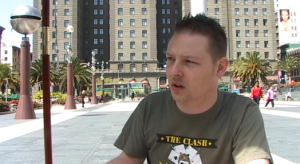 I started editing the documentary with the US segment, as all the footage had been recorded already. I showed it to the gents and they liked the direction the documentary was going in. I also arranged to meet up with Ade to interview him, which we ended up doing standing in a concrete courtyard at FOSDEM. (This interview footage looks the best of them all, I think.) I also approached one of the original presenters, Sparkes, who was supportive of the project but didn’t want to appear on camera. I then began to cut together the other segments, bearing in mind that I hadn’t yet interviewed Matt. It was handy having an interview recorded later than the rest, especially at Matt was there right at the beginning of LugRadio. When I was interviewing Jono and Aq in the US, we didn’t talk very much about the early days because that wasn’t the focus for the documentary at the point. Interviewing Matt later than everyone else meant I could work out which parts of the narrative I didn’t have the right footage for, and tailor the questions I asked him to ensure I got the parts of the story I was missing. It was especially pleasing to interview Matt in the Lighthouse, venue for two LugRadio Lives.
I started editing the documentary with the US segment, as all the footage had been recorded already. I showed it to the gents and they liked the direction the documentary was going in. I also arranged to meet up with Ade to interview him, which we ended up doing standing in a concrete courtyard at FOSDEM. (This interview footage looks the best of them all, I think.) I also approached one of the original presenters, Sparkes, who was supportive of the project but didn’t want to appear on camera. I then began to cut together the other segments, bearing in mind that I hadn’t yet interviewed Matt. It was handy having an interview recorded later than the rest, especially at Matt was there right at the beginning of LugRadio. When I was interviewing Jono and Aq in the US, we didn’t talk very much about the early days because that wasn’t the focus for the documentary at the point. Interviewing Matt later than everyone else meant I could work out which parts of the narrative I didn’t have the right footage for, and tailor the questions I asked him to ensure I got the parts of the story I was missing. It was especially pleasing to interview Matt in the Lighthouse, venue for two LugRadio Lives.
Then followed much reviewing of footage, making notes, editing, writing linking narration, tweaking and backing-up. The process was fairly iterative, cutting out bits, moving the order of clips around until the story was coherent. I hunted through photos, finding ones that illustrated the point being made then generating the pan and zoom clips. I exported the audio from each track and mixed it all separately before re-importing it as I needed to be able to apply quite a lot of audio compression at times, as well as cheating bits of audio in from other places. This was the part of the process from which I learnt the most. It showed up the shortcomings of how some footage had been recorded, but also gave me a better insight into editing techniques. I worked out how edits are “hidden” in professional work, as well as discovering the power of the editor to shape the story being told.
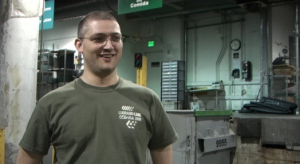 Almost the final part was to get the narration recorded. I knew I wanted a female voice as a contrast to the mostly male voices in the video. Even this part was a learning experience, as I had to direct the session and try and explain to Jenny (who very kindly let me talk her into doing it) what it was she was narrating and how I wanted her to say it.
Almost the final part was to get the narration recorded. I knew I wanted a female voice as a contrast to the mostly male voices in the video. Even this part was a learning experience, as I had to direct the session and try and explain to Jenny (who very kindly let me talk her into doing it) what it was she was narrating and how I wanted her to say it.
Even the relatively simple process of sticking all the segments together and mastering them into a single file took a few evenings of work, purely because of the processing power required. The final output was a 13GB file of Raw DV.
The end result of all this work was seeing the documentary projected on the large screen at LugRadio Live 2009. It was immensely satisfying watching people watching my work! For them it was the first time, whilst I had become so familiar with the clips that I could only see the flaws! Though it’s not a comedy documentary, there were laughs in the right places and it was gratifying to see the six large gents I had interviewed all watching from the audience. I only got to see the first half of the screening as I had to run off and give a talk of my own.
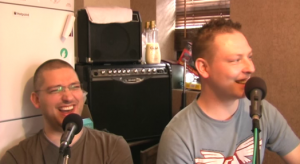 I learnt a lot from making “Don’t Listen Alone” and there are certainly things I would do differently if I were doing it all over again, for example:
I learnt a lot from making “Don’t Listen Alone” and there are certainly things I would do differently if I were doing it all over again, for example:
- Slow down and take time to check everything before recording. You can’t go back. Clean the heads.
- Pay close attention to framing the shots.
- Avoid windy places, or have a big wind gag. Find quieter places.
- Lock the white balance on the camera.
- Have someone operate the camera whilst you interview.
- Pay closer attention to audio levels (preferably have someone else do it.)
- Use one video track for each video source in the editor.
- There’s a weird tilting effect on the interview with Matt which I think is due to the image stablisation system in the camera playing up, but which I couldn’t do anything about given the tools I had available at the time.
- Some of the audio edits are a bit harsh, but needed to be to cut out clicks or other unwanted background noise.
- Allow the narrator time to get warmed up, get familiar with the project and then get them to record each bit as many times as it takes to get it right.
Overall, I’m immensely proud of the documentary. I hope it is a fitting tribute to LugRadio. I’m very grateful to all those who helped make it happen, in particular all those who gave up their time to be interviewed, and everyone who shot footage for it and supported it in any way.
– Tony Whitmore